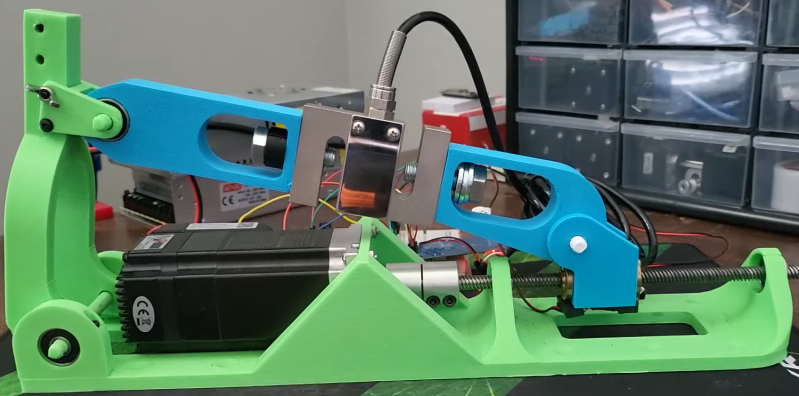Racing virtual cars from behind a PC monitor might be cheaper than doing it in the real world, but high-end sim racing peripherals still come with high-end prices. With the increasing popularity of force-feedback pedals [Tristan Fenwick] built built an active pedal that can provide significant resistance.
[Tristan] integrated a load cell into the 3D printed pedal linkage, which is connected to a 130 W NEMA23 servo motor via a 8 mm lead screw. With constant feedback from the load cell, a simple PID controller running on an Arduino to actively adjust the pedal’s position and the amount of resistance it provides.
At ~$250 in parts, it’s a significantly more affordable than the $2300 price tag on a single Simucube pedal, which served as inspiration for this project. There are still some issues to address, such as shaky ADC readings and a lack of computing power on the Arduino, the demo video after the break looks incredibly promising. [Tristan] also notes that 300 kg is overkill and a slightly smaller servo motor would probably also work.
For more incredible simulator inspiration, check out the A-10 Warthog cockpit, a 3D printed flight sim yoke and pedals, and a tank driving simulator from before the age of computer graphics.
















I can imagine this kind of feedback mechanizm could be adapted into remote-controlled toilet seat. It could always keep the seat tilted just beyond it’s centre of gravity. Fun challenge not to hit it when peeing.
That’s your takeaway?
FYI, a single Wii fit balance board provides four load cells with amplifiers and bluetooth.
Thank you!
available -cheap- at your nearest gamestop
Seems a little silly to put that much work (and expense) into moving the pedal. A real car doesn’t even have that much feedback on the pedals.
The servo range of motion has to cater to the full range of pedal motion. A brake may not move this much, but a throttle or clutch pedal absolutely will. The Simucube ActivePedal (the commercial product that this project is adjacent to) can be used as a throttle, clutch, or brake. And there’s all kinds of feedback that can be relayed through the pedals; ABS vibrations at any point in the brake pedal travel, road vibrations through all pedals, clutch kickback, etc. Modern sim racing software can simulate all of this in concert with peripheral support programs like SimHub.
Real cars absolutely have feedback through the pedals, especially the clutch. The brake pressure also varies with the car’s deceleration force, which contributes to the braking force in a feedback loop. ABS is of course much easier to feel than listen for. All of this can be simulated to give better tactile feedback.
What exactly is the use case? Simulating leaking worn-out brakes?
The main use car is to simulate the pedal rumble of an ABS system in action. Many kinds of touring or GT race cars use ABS and it’s useful to know when you’re engaging it, since peak braking force is achieved *right* before the system kicks in.
You are probably overdoing it with the 24 bit ADC. Extremely hard to get clean signal at those levels. If there is some reason you need that much resolution, you will need good analog AND digital filtering. If you don’t have the processor power (it should) just a rolling average works.
Also you will be feeding car vibrations into the pedal anyway (the whole point), you will probably overwhelm the ADC anyway.
My guess would be a 12 bit would be more than enough. (or just ignore the lower 12 bits if you already have the hardware in place).
Great build!